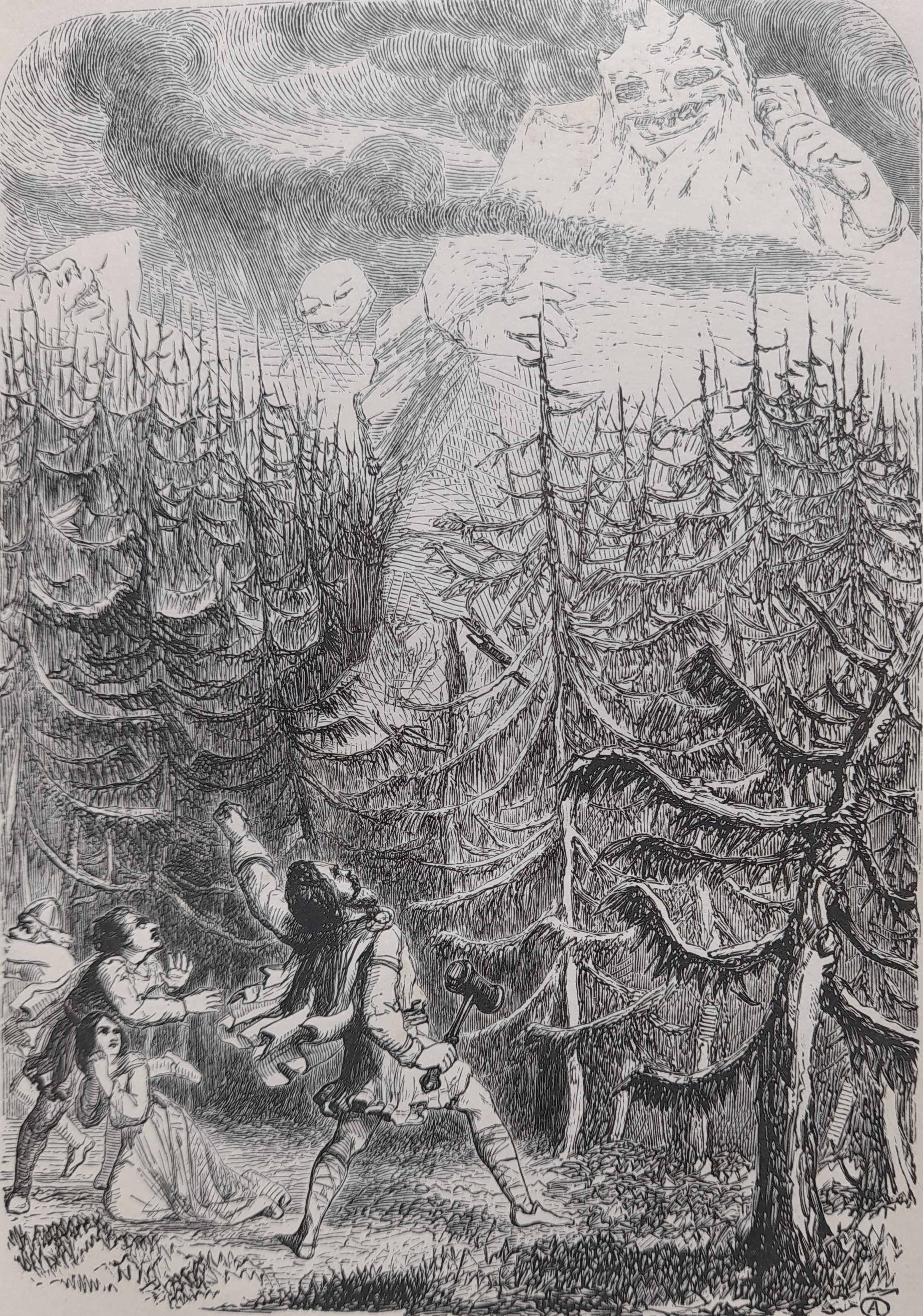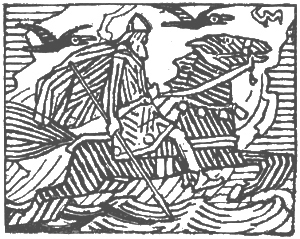"Thor's Attack on the Giant Skrymir"

- Creator: Charles Altamont Doyle March 25, 1832 - October 19, 1893
- Description: This illustration is from a retelling of Norse mythology in the first edition of Annie Keary's The Heroes of Asgard and the Giants of Jotunheim: Or, the Week and Its Story (1857) illustrated by Charles Altamont Dolye. This scene is from the myth concerning Þórr´s Journey to the Court of Útgarða-Loki. Doyle depicts the giant Skrymir confronting Þórr and his traveling companions, i.e., Loki, Röskva, and Þjalfi.
- Source: The Heroes of Asgard and the Giants of Jötunheim, Or, The Week and Its Story
- Folio or Page: 74
- Medium: not known
- Date: 1857
- Dimensions (mm): 80 x 127
- Provenance: This illustration is from The Heroes of Asgard in the collection of the National and University Library of Iceland. Catalogue record: The heroes of Asgard and the giants of Jötunheim : Or, The week and its story Keary, Amie, 1825-1879 höfundur ; Keary, Eliza. London : David Bogue, 1857Í hillu Lbs-Hbs Íslandssafn Almenn rit (Í 823 Kea) Lánstími: Lestrarsalslán
- Rights:
This illustration from The Heroes of Asgard and the Giants of Jötunheim, Or, The Week and Its Story is in the public domain.
-
Research notes, early print reviews, etc.:
- The title page for the The Heroes of Asgard and the Giants of Jötunheim, Or, The Week and Its Story does not name an illustrator nor do the Contents pages indicate that the book contains illustrations. Ken Baitsholts notes that the illustrator is credited as Charles Altamont Doyle in the for 1857, i.e., David Bogue. P. A. Baer notes that David Bogue's Annual Catalogue is included in the The Heroes of Asgard's back matter and that the entry for The Heroes of Asgard and the Giants of Jotunheim cites C. Doyle as the book's illustrator in the listings for "Juvenille Works" (24).
- Early Print review of the first edition of The Heroes of Asgard: "The Scandinavian mythology converted into a tale told for the edification of children, after the manner of books that have taught the Greek and Roman mythology. But no genius can invest the gods of Asgard with the charms of the gods of Oympus. They have none of the grace or dignity. But the authoress has made the best of an unattractive theme." Web. 27 July 2021. (The Critic 130) Full text of the review (ProQuest subscription required).
- Early Print review of the first edition of The Heroes of Asgard: "The fables of the Northern mythology are here reduced to a form adapted to the intelligence of children. They have been cleverly set to an accompaniment of occasional dialogue, lightening and relieving the narrative of giants' wars and of heroic prowess achieved by dwellers in the immortal city. The book is a good specimen of learning made easy by being made pleasant." (The Athenaeum 470) Web. 27 July 2021. Web. 27 July 2021. (470) Full text of the Review (ProQuest subscription required).
- Bibliography:
Editions
Keary, Annie, and Eliza Keary. The Heroes of Asgard and the Giants of Jotunheim: Or, the Week and Its Story. London: Fleet Street: David Bogue, 1857. Print.―. The Heroes of Asgard: Tales from Scandinavian Mythology. London: Macmillan and Co. Limited, 1908.Secondary Sources
Cleasby, Richard and Vigfússon Guðbrandur . An Icelandic-English Dictionary. Oxford: Clarendon Press, 1957.Doyle, Charles Altamont. The Doyle Diary: The Last Great Conan Doyle Mystery : with a Holmesian Investigation into the Strange and Curious Case of Charles Altamont Doyle. New York: Paddington Press, 1978. Print.Review of The Heroes of Asgard, by Annie Keary and Eliza Keary. The Athenaeum, 11 Apr. 1857: 470. Web. 27 July 2021.Review of The Heroes of Asgard, by Annie Keary, and Eliza Keary. The Critic, 16 Mar. 1857: 130. Web July 27, 2021. - Identity Number: HrsAsg-1857-074-01
- Download size: 5.74 MB
- Source code of this document: [XML]
Keary,
Annie Doyle, Charles
Altamont Heroes of Asgard (1857
ed.) Victorian Þórr´s Journey to the Court of Útgarða-Loki, Thor's Journey to the Court of Utgarda-Loki Þórr, Thor, Donner Þjálfi, Thjalfi Röskva, Roskva Loki, Loge Skrýmir, Skrymir Þórr´s Journey to the Court of Útgarða-Loki, Thor's Journey to the Court of Utgarda-Loki

